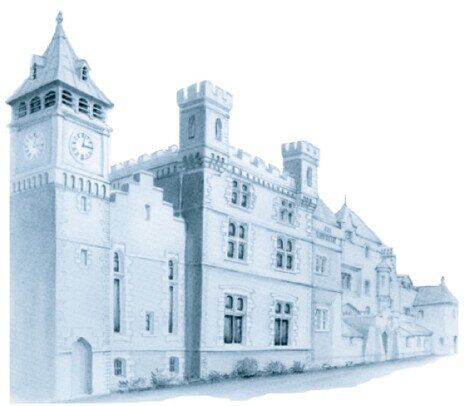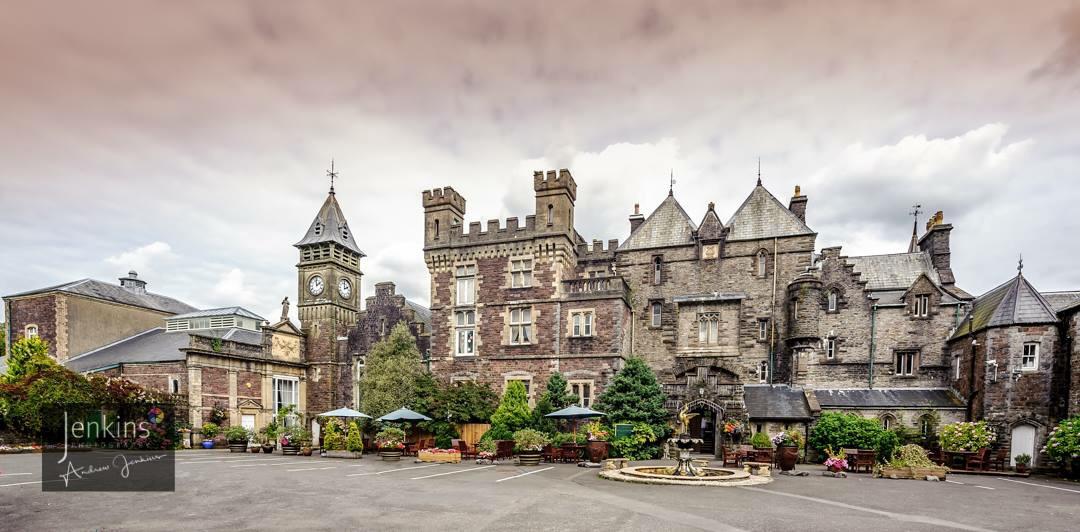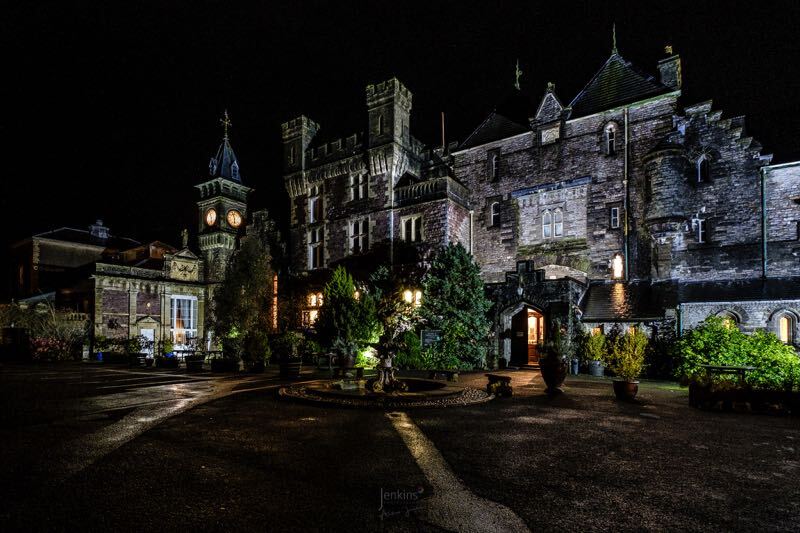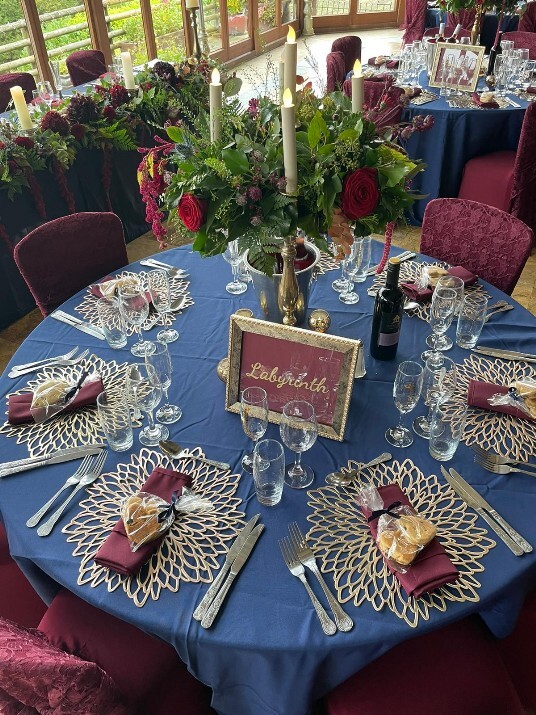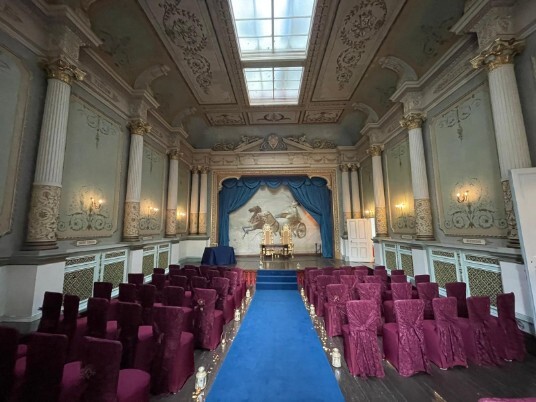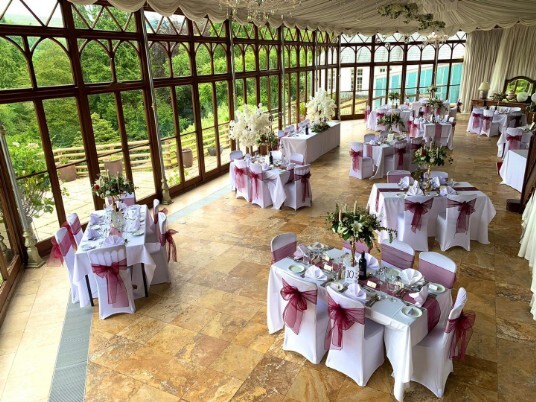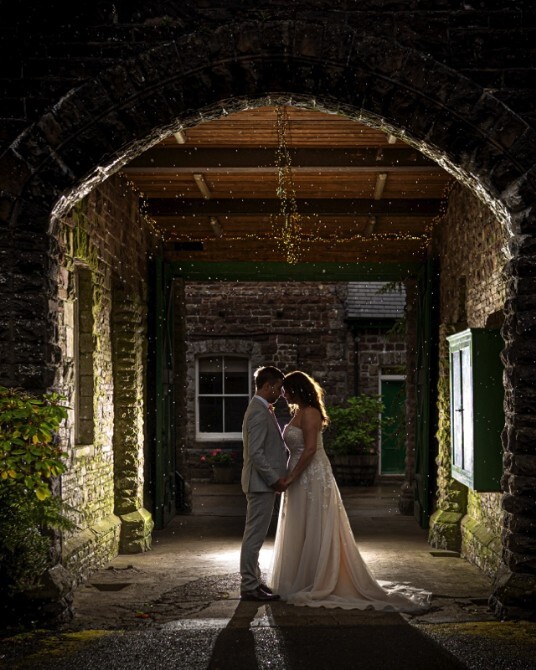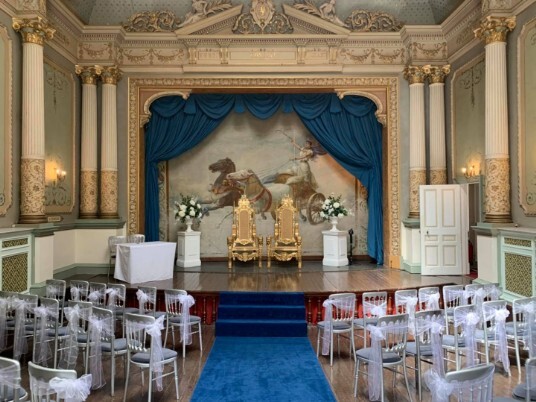Cardiff Wedding Venues - Craig Y Nos Castle Wedding Venue
Cardiff Wedding Venue, for Castle Weddings near Cardiff
- a stunning Wedding Venue
- Time from Cardiff to Craig y Nos Castle Wedding Venue: 1 hour and 2 minutes
- Distance from Cardiff to Craig y Nos Castle Wedding Reception Venue: 44.8 miles

See our Weekend Wedding Package with 60 to 70 day guests and 50 guests staying overnight.
A unique Wedding Venue - the romance of a real Welsh Castle combined with the historic grandeur of our very own Opera House licensed for wedding ceremonies.
Craig y Nos Castle only accepts one wedding a day, so you and your guests from Cardiff will have the run of the whole ground floor of the castle exclusively.
in or near to Cardiff,
or can you go further afield
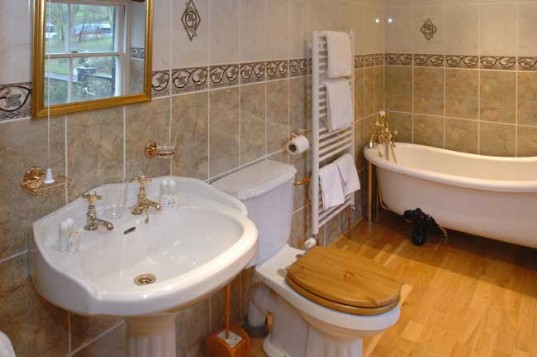
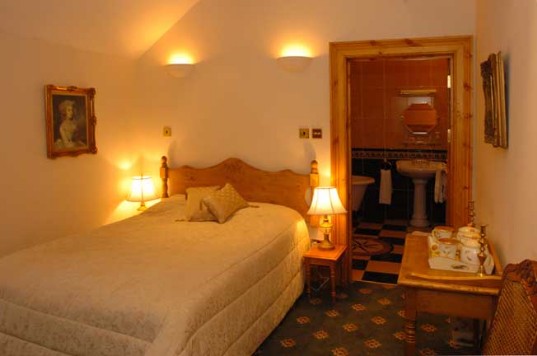
When you choose a venue further away from your base in Cardiff, you'll tend to invite everyone for the whole day. Also you'll need somewhere all your guests can stay overnight.
Unlike with a 'local' wedding reception, when you marry at Craig y Nos, you won't have so many guests shooting off early to get home. With more local weddings nearer to Cardiff, a wedding party dwindles around 11-12 as guests leave to go home. Having everyone stay over at Craig y Nos means your party lasts late into the night.
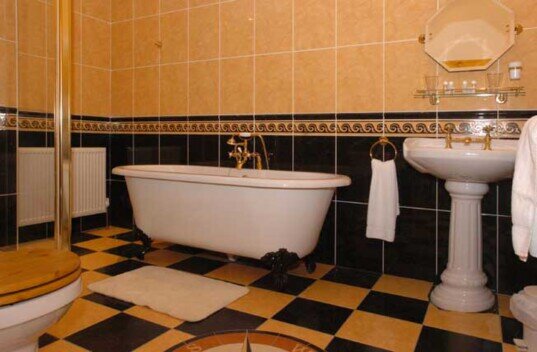

The mountain scenery of the Brecon Beacons National Park guarantees you stunning photo opportunities both inside and outside the castle. The Grade One Listed Opera House makes a fantastic setting for your wedding ceremony. You get exclusive use of the whole ground floor of the castle for you and your wedding guests.
1. Population: Cardiff local authority area had a population of 346,100 at the 2011 census and Cardiff larger urban zone 861,400. Cardiff is the 10th largest city in UK though it was for many centuries a small town of under 2000. It grew in size as a coal port. Coal for making iron and later steel was brought to Cardiff by packhorse from Merthyr Tydfil and then via a canal from Merthyr to the Taff Estuary at Cardiff. Later the Taff Vale Railway transported the coal from Merthyr to Cardiff which grew due to the huge demand for coal.
2. King Edward VII granted Cardiff city status on 28 October 1905 and Cardiff was made the capital of Wales in 1955. For a while Cardiff's Port was the busiest in the world exporting 10 million tons of coal a year. Even today Cardiff Port exports 3 million tons of goods.
3. 18 million visitors annually generating £852 million in income. 1:5 are employed in the tourism industry and Cardiff has 9,000 hotel beds.
4. The Welsh Assembly and BBC Drama Village have contributed to the redevelopment of Cardiff Bay.
5. Cardiff was the European City of Sport in 2009 and will be again in 2014 with a number of stadiums: the Millennium Stadium (national stadium for Wales national rugby union team and Wales national football team), SWALEC Stadium (Glamorgan County Cricket Club), Cardiff City Stadium (Cardiff City football team), Cardiff International Sports Stadium (Cardiff Amateur Athletic Club) and Cardiff Arms Park (Cardiff Blues and Cardiff RFC rugby union teams).
6. The name Cardiff derives in part from the Welsh word Caer meaning fort, and the River Taff, which flows by Cardiff Castle.
7. Neolithic people settled in and around Cardiff circa 4000 BC. Before the Romans, Cardiff and the surrounding areas of what later became Breconshire, Powys and Glamorgan, was occupied by the Silures, who were a Celtic British tribe that flourished in the Iron Age. The Roman fort built in 75 AD was an extension of the forts around the main Roman base at Caerleon. However little is known about the peoples of Cardiff between the Romans leaving in the C.4th and the Norman Conquest in 1081. It is possible Cardiff was abandoned at this time as Wales was divided into a number of small kingdoms. In the C.10th to C.13th, the population of Cardiff was around 1,500 to 2,000.
8. Cardiff Castle was built in 1091 though it has been renovated and added to since. In 1404 Owain Glyndŵr burned Cardiff and took Cardiff Castle. As the town was small and most of the buildings were made of wood, the whole town was destroyed. However, the town was soon rebuilt and began to flourish once again as a busy port.
9. A flood in 1607 in the Bristol Channel, which may well have been a tsunami, caused the River Taff to be redirected.
10. During the Civil War, Cromwell beat the Parliamentarians at the Battle of St. Fagans, enabling Oliver Cromwell to conquer Wales. This was the last major battle in Wales.
11. Cardiff was still a small town as late as the 1790's; it was described as "an obscure and inconsiderable place" by one writer of the time, and the population had only increased to 1,870 by the 1801 census. Merthyr and Swansea were larger towns.
12. John Crichton-Stuart, 2nd Marquess of Bute built the Cardiff docks and is now recognised as "the creator of modern Cardiff". The town expanded rapidly from the 1830's. Cardiff became the main port for exports of coal from the Cynon, Rhondda, and Rhymney valleys, and grew at a rate of nearly 80% per decade between 1840 and 1870. Cardiff became the world's biggest exporter of coal and iron. Cardiff Coal Exchange established in 1886 used to set the price of the world's coal.
13. Cardiff generally preferred to be more British than Welsh, as demonstrated in the 1997 devolution referendum; Cardiff voters rejected the establishment of the National Assembly for Wales by 55.4% to 44.2%. The National Assembly for Wales has been based in Cardiff Bay since its formation in 1999. Known as the Senedd (meaning Legislature, Parliament or Senate), the Assembly was opened on 1 March 2006, by The Queen.
3. The different kingdoms of Wales – if you wanted to reflect the history of Wales up to Cardiff becoming the capital.
4. Name your tables after the areas or wards (soe of them – that is) of Cardiff.
5. Visit the Museum of Welsh Life at St. Fagans for inspiration, possibly building table centres modelled on some of the old style Welsh houses.
6. If you are into walking or cycling you might wish to feature the Taff Trail’s scenic spots or names of places it passes through.
7. Feature Cardiff’s key buildings as your table names, possibly complete with centrepieces based on models of the buildings – if these can be obtained – e.g. the Millennium Stadium, Welsh National Museum, Senned (National Assembly for Wales) Building, Cardiff Castle, Llandaff Cathedral, Castell Coch, Coal Exchange and other landmark buildings.
8. The same can be done incorporating as table names and centrepieces all the castles in and around Cardiff – which will fit in with a castle theme for your wedding if marrying at Craig y Nos Castle wedding venue.
9. You may take inspiration or supplies from any of the various Festivals in Cardiff.
10. Check out the list of famous people in Cardiff and decide if you want to reflect them or their achievements / history.
Old St Mellons dates back to the Norman Conquest in the 11th century. Rural areas include the villages of St. Fagans, Creigiau, Pentyrch, Tongwynlais and Gwaelod-y-garth.
17. St. Fagans is home to the Museum of Welsh Life. The National History Museum at St Fagans in Cardiff is a large open air museum housing dozens of old historic buildings representative of Welsh history that have been dismantled and moved from their original location and reassembled at St. Fagans in Cardiff.
In 2011 Which? Travel magazine readers named St Fagans National History Museum as their favourite attraction in the UK.
Valleywood Studios at Rhondda Cynon Taff will be the biggest film studios in the UK. The BBC is to build new studios in Cardiff Bay to film dramas such as Casualty and Doctor Who, with the BBC to double media output from Cardiff by 2016.
20. Cardiff is the sixth best city in the UK for shopping.
21. The Taff Trail is a walking and cycle path running for 55 miles from Cardiff Bay to Brecon in the Brecon Beacons National Park. It runs through Bute Park, Sophia Gardens and many other green areas within Cardiff.
One can cycle the entire distance of the Trail almost completely off-road, as it follows the River Taff and the old disused railways in Glamorganshire's valleys.
On Sundays in summer the Beacons Bike Bus enables cyclists to take their bikes into the Beacons and then ride back to Cardiff along the Trail.
22. Cardiff key tourist / landmark buildings:
Millennium Stadium,
Pierhead Building,
the Welsh National Museum,
the Senedd housing the National Assembly for Wales,
- Cardiff Castle,
St David's Hall,
Llandaff Cathedral
the Wales Millennium Centre,
Castell Coch (an elaborate Victorian folly which has replaced the original castle),
Cardiff Bay,
Cardiff Bay Barrage
the Coal Exchange
Cardiff Story museum, which documents the history of Cardiff.
National Geographic magazine chose Cardiff as one of the 10 best places in the world to visit in 2011.
23. Cardiff has the largest concentration of castles of any city in the world. There is Cardiff Castle and Castell Coch, the ruins of Twmpath Castle, Llandaff Bishop's Palace and Saint Fagans Castle though the site of Whitchurch Castle has now been built on.
24. Cardiff hosts numerous large, high profile events, including Britain’s largest free summer festival.
Annual Festivals include:
Sparks in the Park
the annual Great British Cheese Festival in Cardiff Castle (the Independent Newspaper listed the Great British Cheese Festival, second in its list of top 10 Food Festivals in the UK)
Cardiff Mardi Gras
Cardiff Winter Wonderland
Cardiff Festival
the Cardiff Big Weekend Festival (live music - this is the largest outdoor free festival inthe UK attracting 250,000 visitors)
the Childrens' Festival in Cardiff Castle's grounds.
25. Famous People from Cardiff: Charlotte Church, Shirley Bassey, Roald Dahl, Ken Follett, Griff Rhys Jones, broadcaster and journalist John Humphries, Singer Shaking Stephens, Tommy Cooper (from neighbouring Caerphilly), and Tom Jones the singer (from Pontypridd).
Cardiff’s Millennium Stadium has one of the largest sliding roofs in the world. It can seat 74,000 and has hosted the Rolling Stones and Neil Diamond.
28. Cardiff has been designated as the world’s first Fair Trade Capital - encouraging ethical trading and fair prices for producers in third world countries
29. The world's first £1million cheque was signed in Cardiff's Coal Exchange.
30. Cardiff has a reputation as a vibrant centre of learning and has one of the largest student populations in the UK.
31. St. David’s Centre is one of the largest shopping centres in the UK.
![]()
Wedding Availability - Years |
Wedding Themes - Towns Index | |
1 | |
2 | |
3 | |
4 | |
5 | |
6 | |
7 | |
8 | |
9 | |
10 | |
11 | |
12 | |
13 | |
14 | |
15 | |
16 | |
17 | |
18 | |
19 | |
20 | |
21 | |
22 | |
23 | |
24 | |
25 | |
26 | |
27 | |
28 | |
Day | Min No's | Wedding Packages |
Sat Fri | 70 60 | |
Sun- Thu | 50 | |
Wedding Package Selector - check which wedding package best fits | ||
Any day | 50 | |
Sun- Thur | 25 | |
Wed only | 40 | |
Any Day | 100 | |
Any Day | 70 | |
Tariffs | ||
![]()
